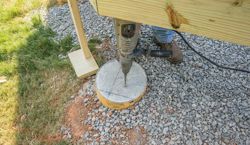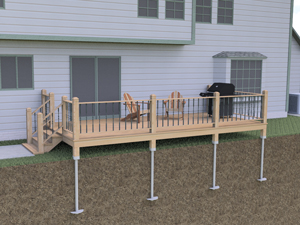From Principle to Concrete: The Essential Function of Deck Footings in Sturdy and Safe Decks
From Principle to Concrete: The Essential Function of Deck Footings in Sturdy and Safe Decks
Blog Article
Selecting the Right Deck Footings for Stability and Longevity
The durability and safety of your deck depend greatly on the kind of footings you choose, as they give the crucial assistance and security to hold up against the test of time. In this discussion, we will certainly explore the numerous kinds of deck footings, think about the vital elements to evaluate when making a choice, and delve into the pros and cons of various alternatives.
Sorts Of Deck Footings
These footings consist of a cylindrical hole filled with concrete, which offers a solid structure for the deck posts. Concrete pier footings are relatively easy to mount and supply outstanding stability, making them a prominent option for numerous deck jobs.
One more sort of ground is the helical heap ground. Helical stacks are steel shafts with helical plates attached to them. These footings are installed by screwing them right into the ground, which develops a protected structure for the deck. Helical stack grounds are perfect for areas with tough dirt conditions, as they can be installed in nearly any type of kind of soil. They additionally permit for simple adjustment and leveling of the deck if required.
Alternatively, some builders select precast concrete grounds. These footings are constructed from long lasting concrete and be available in various forms and sizes to accommodate different deck layouts. Precast concrete footings are hassle-free to set up and provide a steady base for the deck structure.
Lastly, another choice is the post-in-anchor footing system. This kind of footing involves driving a steel anchor into the ground and attaching it to the deck post. It uses versatility in regards to positioning the deck messages and appropriates for decks with lightweight frameworks.
When selecting the appropriate type of deck ground, it is important to take into consideration factors such as soil problems, deck lots, and local building codes (Deck Footings). Consulting with a specialist service provider or architectural engineer can assist make certain the appropriate ground is picked for a safe and steady deck
Variables to Think About When Picking Grounds
When selecting the suitable grounds for a deck, it is important to carefully think about different variables such as dirt conditions, deck load, and adherence to neighborhood structure codes. These factors play a considerable function in making certain the stability and longevity of the deck structure.
One of the primary variables to take into consideration is the dirt problems. The sort of dirt on which the deck will be developed determines the sort of footings required. For circumstances, decks built on loose or sandy soils may require much deeper footings to provide sufficient support and avoid settling. On the other hand, decks improved clay or expansive soils may call for grounds that can fit the soil's tendency to broaden and agreement.
An additional vital aspect is the deck tons. The weight of the deck, including the materials used and any kind of prospective live loads such as furnishings or events, need to be taken into consideration when selecting footings. The footings must be made to birth the weight of the deck and distribute it uniformly to stop any kind of structural issues or failings.
Finally, adherence to local building ordinance is vital. Building codes differ from region to area, and it is necessary to adhere to the details requirements established by the regional authorities. Deck Footings. These codes make sure that the deck is constructed safely and meets the needed requirements for architectural stability and load-bearing capacity
Concrete Footings: Benefits And Drawbacks

When made use of as the structure for a deck,Concrete grounds offer a number of advantages and disadvantages. On the silver lining, concrete grounds offer outstanding stability and durability. Concrete is a rigid and strong material that can sustain hefty loads and stand up to various climate condition. It additionally has a long life-span, making it a reliable choice for long-lasting use.
An additional benefit of concrete grounds is their adaptability. They can be put into different sizes and shapes to suit numerous deck layouts and arrangements. Concrete footings can be customized to fit the specific needs and needs of the deck structure.
Nevertheless, there are likewise some drawbacks to Check This Out using concrete grounds. One significant downside is the cost and labor involved in their installation. Concrete grounds need excavation and usually require the help of hefty equipment. This can enhance the overall cost of the deck task and might require professional assistance.

Helical Piers Vs. Sonotubes: Which Is Better?
In taking into consideration the foundation options for a deck, the comparison between helical piers and sonotubes is crucial in identifying the exceptional selection. Helical piers, also called screw stacks, are steel shafts with helical plates connected to them. They are turned right into the ground making use of hydraulic equipment, giving a stable and long lasting structure for the deck. On the various other hand, sonotubes are round kinds constructed from cardboard or fiber product that are loaded with concrete. They are put in a hole dug into the ground and supply assistance for the deck.
When it pertains to stability and toughness, helical piers have the upper hand. The helical plates on the piers create a strong hold with the soil, shifting or protecting against any type of motion of the deck. This is especially valuable in locations with unsteady or shifting dirt problems. Sonotubes, on the other hand, rely his comment is here only on the concrete filling for stability, which might not supply the very same degree of toughness and resistance.
In terms of installment, helical piers are relatively less complicated and faster to install contrasted to sonotubes. The hydraulic machinery made use of to twist the piers right into the ground ensures a fast and reliable process. Sonotubes, on the other hand, call for digging holes and putting concrete, which can be time-consuming and labor-intensive.
Additionally, helical piers are an even more versatile choice. They can be used in different dirt problems and can be changed or enhanced if needed. Sonotubes, on the various other hand, might call for added support, such as rebar, in certain soil problems or locations with high lots requirements.
Selecting the Right Footings for Your Deck's Measurements
For optimum architectural integrity, it is essential to very carefully pick the appropriate footings that align with the dimensions of your deck. The dimensions of your deck, including its elevation, size, and length, play a considerable role in figuring out the kind and dimension of grounds required.
When choosing footings for your deck, it is essential to think about the load-bearing capability of the soil. The weight of the deck, integrated with the weight of any kind of furnishings or individuals on it, puts in a substantial pressure on the grounds (Deck Footings). As a result, it is essential to choose footings that can appropriately support this weight without changing or sinking with time.
The shapes and size of the grounds ought to likewise be taken into consideration. Bigger decks with better dimensions call for bigger footings to provide sufficient security and support. Get More Info The shape of the footings, whether they are rounded or square, depends on the design and format of the deck. Furthermore, the depth at which the grounds are installed should be determined based upon the frost line in your region to avoid any heaving or changing as a result of freezing temperature levels.
Conclusion
To conclude, picking the ideal deck footings is crucial for guaranteeing stability and durability. Aspects such as the sort of footings, the deck's measurements, and the advantages and disadvantages of various choices should be thought about. Concrete grounds provide toughness and longevity, but might be more lengthy and pricey to install. Helical piers and sonotubes have their own benefits and negative aspects. Eventually, picking the ideal footings for your deck's certain demands is important for a successful and resilient framework.
These grounds are composed of a round opening filled with concrete, which offers a strong structure for the deck posts. Concrete pier footings are fairly simple to set up and supply excellent stability, making them a popular option for several deck projects.
Precast concrete footings are practical to mount and offer a secure base for the deck structure.
It uses adaptability in terms of placing the deck blog posts and is ideal for decks with light-weight frameworks.
Concrete footings provide a number of advantages and downsides when made use of as the structure for a deck.
Report this page